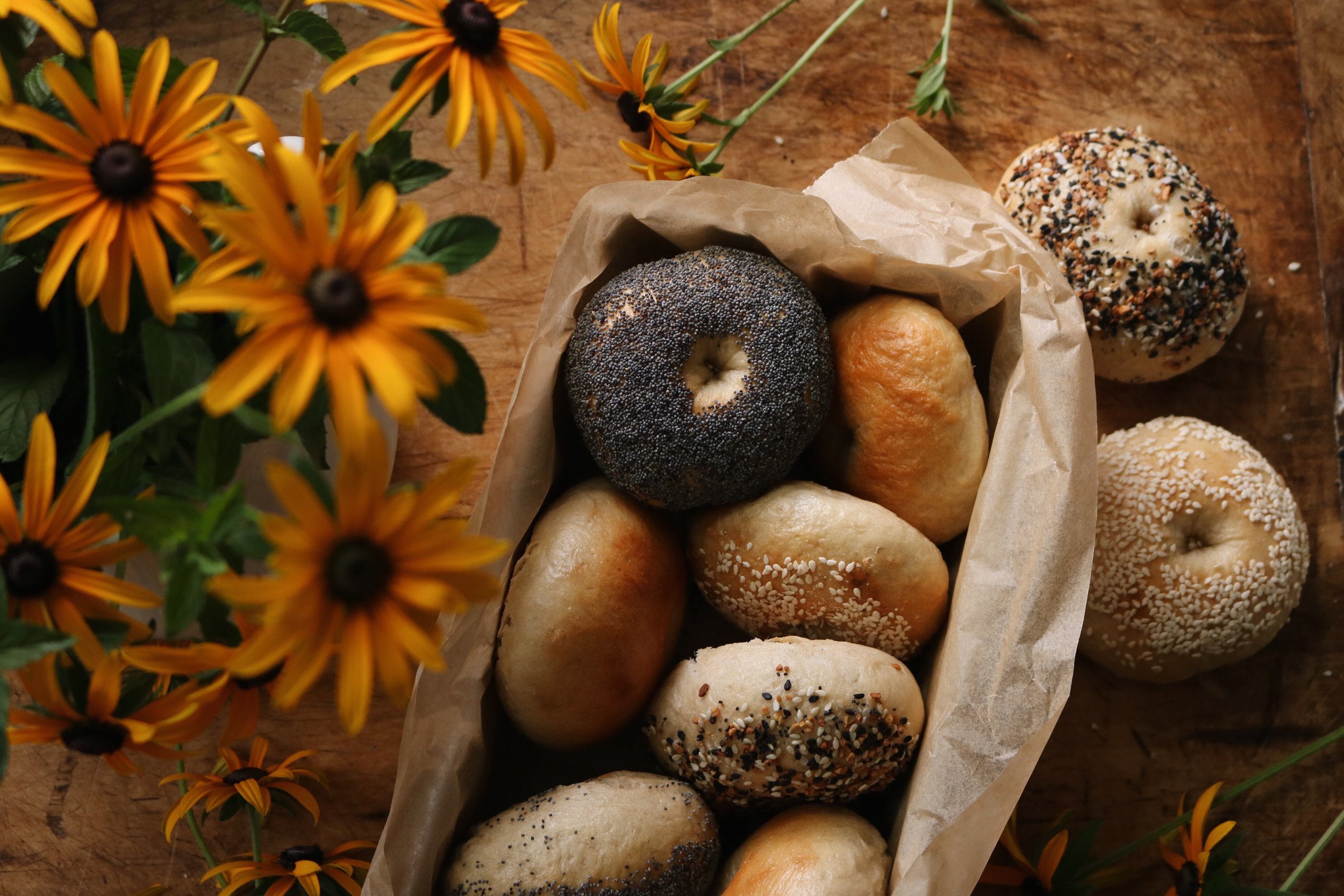Sourdough Simplified: Homemade Bagels
why sourdough simplified?
When I began my sourdough journey over 3 years ago, I was completely overwhelmed. Sourdough seems to be one of those things where everyone has their own method and each method is different, but they all seem to work just the same. It’s confusing to know where to start and who to listen to.
When I cultivated my first starter, it felt like a success! However I had no idea what to do with it next, and I didn’t have a bread recipe. I spent hours upon hours reading different methods and recipes and ended up incredibly frustrated.
I didn’t want to bake a fancy artisan loaf. I didn’t want to buy a kitchen scale or a banneton basket. If Ma Ingalls could make sourdough without a kitchen scale, so could I. (One of the biggest pieces of advice I see amongst sourdough circles is to invest in a good kitchen scale. You certainly can if you’d like, but it’s not absolutely necessary.) I wanted to use my measuring cups and the tools I already had. I also wanted a simple method of keeping and feeding my sourdough starter that didn’t create a lot of excess discard.
After much trial and error I’m at the place where I am pretty confident in my sourdough making. My loaves are not professional by any means, but they are exceptionally frugal to make, traditionally fermented therefore easy to digest, and taste delicious!
I started my “Sourdough Simplified” series to share my methods and tips I’ve learned along the way. This is not the only way to do things by any means. But it’s one way, and I do find it to be much simpler than some of the methods I’ve come across. Keeping the breadbox full shouldn’t be a task that takes a lot of time or effort. It should be—simple.
In the fourth post of this series I am sharing my bagel recipe. I’ve tried a lot of sourdough bagel recipes in my days and it’s taken awhile to find one that’s just right. In the fall and winter months you’ll find me making Clever Carrot’s Sourdough Pumpkin Bagels (I omit the pumpkin pie spice + sugar topping so they can be used for savory sandwiches too). These are my favorite because we use an abundance of squash purée from autumn through late spring. I’m always looking for ways to sneak purée into everyday meals. But in the summer months, we aren’t roasting squash and that led me to modifying the recipe for basic bagels.
I know the boiling sounds intimidating, but I promise it’s not! The extra step is worth it. The boiling is what gives them that classic chewy crust. This recipe yields about 9 bagels. Let’s dive in!
what you need:
3/4 cup of active, bubbly sourdough starter
1 cup of filtered water (room temp or slightly warm)
2 tablespoons of cane sugar, local honey, or maple syrup
3 1/2-4 cups of organic unbleached, unbromated all-purpose flour
1 1/2 teaspoons of sea salt
Sesame seeds, poppy seeds, or other desired toppings
More filtered water and honey for boiling
baker’s schedule
day 1:
MORNING: The morning before baking, I wake up, remove my starter from the fridge, and give it a generous feeding.
EVENING: Before bed, I follow the recipe to mix up the dough and place it in an oiled bowl.
NIGHT: Covering the dough with either a plate or a wet tea towel, I let it ferment overnight. By the time I wake up on the second morning, it is doubled in size and ready to go.
day 2:
MORNING: As soon as I wake up, I divide the dough into 9 pieces, shape into balls, make the holes, and let them rest on a floured surface while I enjoy my coffee and morning devotions. Meanwhile, the pot of water is heating to boil the bagels and the oven is preheating as well.
I then boil, bake, cool, slice, store in a breadbox, and enjoy throughout the week!
Keep in mind that during the summer when the house is really hot, this bakers schedule is more compact because the heat causes everything to rise faster, both the starter and the dough.
to make
step 1:
Begin by feeding your starter the a few hours before you will be baking the bagels. You want your starter to be active and bubbly for this recipe.
step 2:
Once the starter has doubled, in a stand mixer with a dough hook or in a bowl by hand (a danish dough whisk is great for this step!), combine your active sourdough starter, water, sweetener, and about 1 cup of the flour.
step 3:
Begin mixing to combine, adding more flour a little at a time. You may need more or less than 3 1/2 cups depending on how hydrated your starter is, as well as the weather, so add slowly. Add in your salt at this time too. Continue mixing for about 5-10 minutes until the dough begins to come away from the edge of the bowl and is smooth and elastic.
step 4:
Form the dough into a ball and place it in a clean oiled bowl, seam side down. Cover the bowl with a wet tea towel or plate and allow the dough to ferment overnight. It is during this time that it will get light, airy, and active, doubling in size.
step 5:
The next morning, your dough should be doubled in size with strong gluten strands. Turn the dough from the bowl onto an unfloured surface and divide into 9 pieces and shape them into tight balls using the tension of the countertop.
step 6:
Create holes in each ball of dough by pressing your thumb through the center and giving them a gentle stretch. Set them aside on a floured surface and cover them with a damp tea towel.
step 7:
At this time, preheat the oven to 425°F and bring 2 quarts of water to a boil. I like to stir in a tablespoon or two of local honey at this time too, but isn’t necessary.
Before baking
After baking
step 8:
Boil the bagels for 30 seconds on each side. Only add 2 or 3 to the pan at one time so they have enough room to float around. Remove them with a slotted spoon and transfer to a clean tea towel to allow any excess water to drain. While the bagels are still slightly wet from boiling, add any desired toppings and then transfer to a baking tray.
step 9:
Once all the bagels are boiled and the oven is preheated, bake for about 20-25 minutes or until they are golden on the top. Remove from the oven and transfer to a cooling rack. Allow them to cool for at least an hour before diving in. This is such an important step, as bread continues to bake once it is removed from the oven and will ensure the best crumb if cooled completely.
step 10:
Store in a breadbox for fresh keeping or slice and freeze for later use. Enjoy!
That’s that! How did they turn out for you? What questions do you have?
I will be continuing Sourdough Simplified in future posts. Is there anything specific you would like me to cover, or a sourdough recipe you’re hoping I’ll share?
Until next time, happy baking!
“Blessed shall be your basket and
your kneading bowl.”











